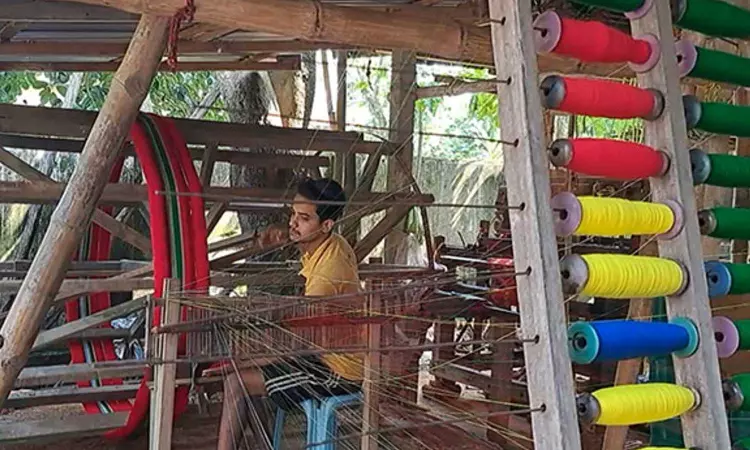Tripura: Traditional indigenous attire primary source of income for people of Taranagar
Both the traditional garments are an integral part of Tripura's cultural identity and rich heritage, which is why these were accorded the Geographical Indication tag earlier this year.

Traditional indigenous attire weaved by Bengali weavers in Tripura's Taranagar (ANI)
AGARTALA: Located on the outskirts of the capital city Agartala, Taranagar is a small hamlet of Bengali weavers in West Tripura district that stands as a glaring example of the pristine cultural diversity of Tripura. Even though all the weavers in this village belong to the majority Bengali community, their primary source of income comes from the traditional tribal attires such as 'Risha' and 'Rignai'.
Both the traditional garments are an integral part of Tripura's cultural identity and rich heritage, which is why these were accorded the Geographical Indication tag earlier this year. According to the weavers of the village, they had started weaving tribal garments such as Risha and Rignai for the last six to seven years as the demand for the product skyrocketed. Kamala Sarkar, a weaver from the village said that 'Risha' and 'Rignai' are in high demand after the BJP government came to power.
"For the last 30 years, we have been in this business of handloom. For the last six to seven years, we have started weaving Risha and Rignai as well. Even though these are primarily tribal clothes, we started weaving these garments after the BJP government came to power. The government purchase orders for Risha have also been substantially enhanced," she explained.
According to Sarkar, since they are selling most of their products in the open market which is full of competition, the prices of the products have taken a dip in recent days.
"Earlier, we used to get good prices but in recent times the prices are lying a bit low because of the open market competition. If the demands were generated through the village-level cluster organisations, we would have fetched better prices. If the prices of the products improve, we could have made better profit margins," Sarkar pointed out.
Another weaver Santi Das claimed that 80 per cent of the state's total production of the Risha is contributed by Taranagar village.
"We mainly weave Risha, bed sheets, and bandages for the government hospitals. For the last 20 years, I have been in this profession and nowadays Risha has become the most selling product of this village," he said.
On being asked about their production, he said, "One handloom can easily produce 10 Rishas a day. More than 300 pieces are produced every month. Most of our products go to the open market but Purbasha (the state government body for handloom products) also issues purchase orders at regular intervals. So far my knowledge goes, around 80 per cent of the state's total production of Risha comes from Mohanpur area."
On being asked as to why they shifted to tribal attires, he said, "When Biplab Kumar Deb became the Chief Minister of Tripura, he worked hard to give Risha a wider acceptance and appreciation. We the weavers of this village are reaping rich dividends of his initiatives."
In the village, there are around 20 families who own handloom units while more than 100 people are working in these looms as skilled labourers.
Suklal Das, who works in the handloom unit of Navin Das said, "There are around 120 people in our village who operate the looms. At the peak of the season, we received a decent wage of Rs 500 to 550 per day. The peak season runs for five months from the Bengali month of Bhadra to Poush."
On being asked about Risha and Rignai, he said, "It is a fact that the products we produce in our looms are used by the tribal people of the state. The people of the indigenous communities see weaving as a household chore but here we are doing it at a commercial scale which is why production in our village is on the higher side."
It is worth noting here that 'Risha' and 'Rignai' are unavoidable parts of traditional indigenous clothing of women. While 'Rignai' is a bottom wear, Risha has multiple uses such as headgear, scarf and upper wear.



